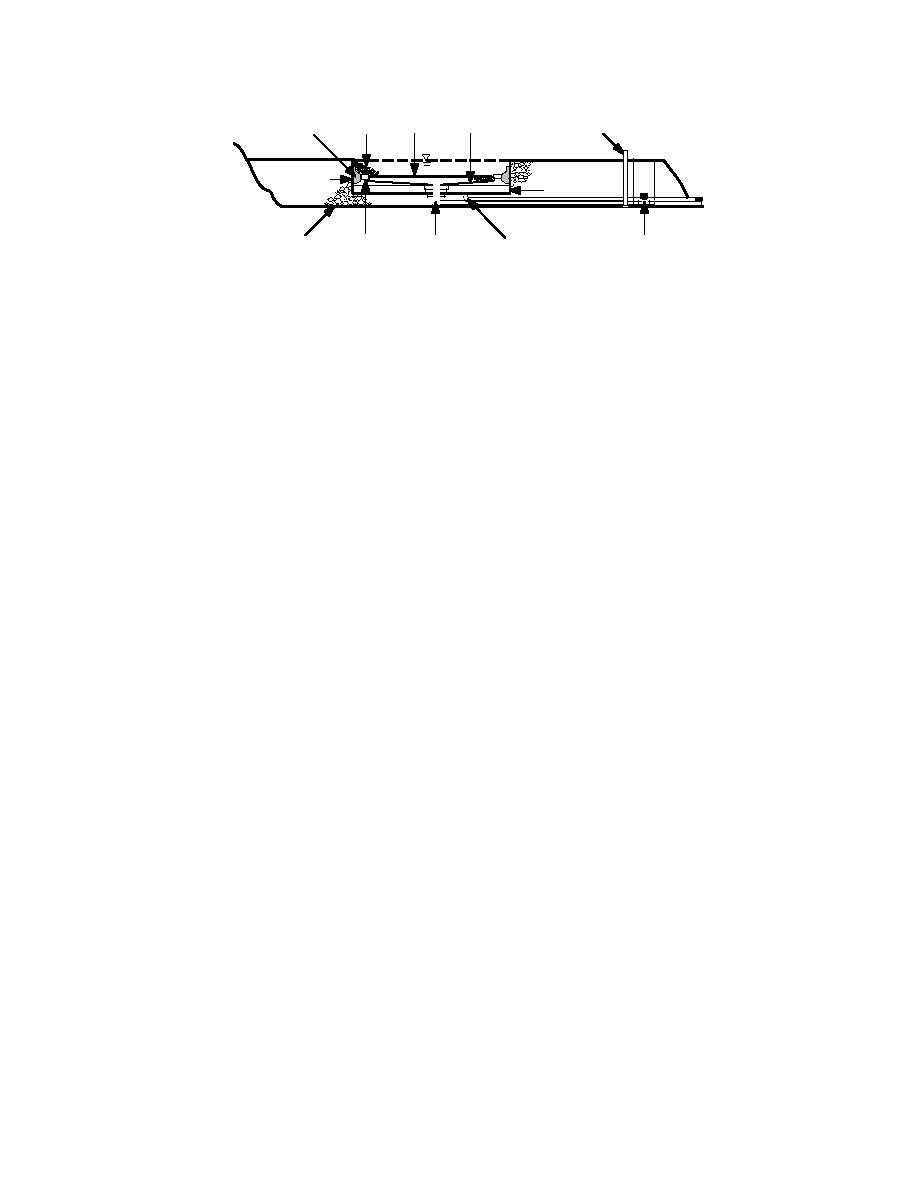
PVC
1 cm
20 mil PVC
Pea Gravel GCL
Cover Strip
Vent Pipe
Membrane
Bentonite
0.6 cm
Edge
HDPE Tank
Seal (paste)
Seepage
Side Leakage
4 cm
Bentonite
PVC Seepage
Drain
Drain
Minus Stone
Paste
Collection Control
Valve
Figure 3. Details of the GCL test pans.
underlying HDPE. Piping and filter material were
Nine test pans (Fig. 1) were constructed in three
installed that connected to the geonet drain
groups (one group for each GCL). Each group con-
(placed below clay before compaction), thus
tained two sizes of test pans. Two test pans in a
group had a surface area of about 8 ft2 (0.75 m2).
allowing water that seeps through the block of
clay to flow to a sump for observation and possi-
The third test pan in each group had a surface area
of 20 ft2 (1.9 m2). The large test pan and one of the
ble measurement. The 4-in. (10-cm) space be-
tween the block of clay and the inside wall of the
small test pans in each group were used to test a
HDPE box was filled with bentonite grout to pre-
GCL with a seam in the long dimension. The seams
vent side leakage. A layer of nonwoven geotextile
were made in accordance with the manufacturer's
was placed on top of the clay and covered with a
specifications. The other small test pan in each
layer of coarse, 2-in. (5-cm) or smaller washed
group contained a GCL with no seam.
gravel that filled the space between the top of clay
The smaller test pans were commercially avail-
and the top of the HDPE box. An HDPE lid was
able HDPE storage pans. The larger ones were
placed and seamed on top of the box. A 1-in.- (2.5-
made by welding together pieces of HDPE plate
cm-) diameter PVC riser pipe was placed at the
stock (Fig. 3). A seepage collection system with
high point of the lid to allow water to be added to
drains was designed and constructed in each test
the system and inflow of seepage to be measured.
pan and then covered with a GCL. Bentonite caulk
During testing, the permeameters were cov-
and strips of plastic were used to prevent leakage
ered with about 2 ft (0.6 m) of sand or gravel. This
along the sides of the GCL, which was then cov-
material was placed to hold the flexible HDPE lid
ered with about 10 in. (25 cm) of pea gravel to the
in place so that uplift of the lid was prevented.
top of the test pans.
Seepage was measured by filling the riser pipe
The area surrounding the test pans was filled
until the water level stabilized, and then regularly
with gravel to the same level as that in the pans,
monitoring water levels. In winter, the sand cover
so that freezing and thawing would be one-
was reduced to 4 in. (10 cm) so that the cover over
dimensional.
the permeameter was the same as that over the
Water was initially added to the test pans to a
rest of the test pad.
depth of 1 in. (2.5 cm) over the GCLs to allow the
bentonite to hydrate under low head conditions.
GCL test-pans
After 1 week at the low head condition, more wa-
Our goal during the GCL portion of the field
ter was added. The test pans were allowed to hy-
investigations was to compare and investigate
drate under this condition for 1 month before we
began collecting seepage data. The water level was
and after winter. Three 32- 13-ft (10- 4-m)
kept relatively constant during the tests. Hydraulic
ponds, each lined with a different GCL under 10
gradients used in the field test pans ranged from 5
in. (25 cm) of cover, were constructed during the
to 15 and averaged 10. The test pans were not
fall of 1992 (Fig. 1). The ponds had underdrains
drained for winter; they remained full of water.
beneath them. The goal was to measure the
Water from a surface water pond located adjacent
hydraulic conductivity after freezing and thaw-
to the landfill was used as the permeant.
ing. However, a flaw in the seepage measurement
The seepage through the GCL and the seepage
system prevented it from working as planned.
past the edge of the GCL were separated by the
The problem could not be corrected, so a different
collection system. This was done so that water
test system was designed and constructed in Sep-
from a leaking edge seal would not be mistakenly
tember 1993.
included with seepage through the GCL. The flows
6



 Previous Page
Previous Page
